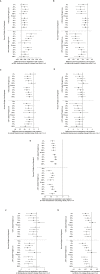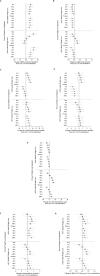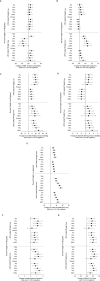Change in Cardiometabolic Risk Factors Associated With Magnitude of Weight Regain 3 Years After a 1-Year Intensive Lifestyle Intervention in Type 2 Diabetes Mellitus: The Look AHEAD Trial
- PMID: 31594431
- PMCID: PMC6818027
- DOI: 10.1161/JAHA.118.010951
Change in Cardiometabolic Risk Factors Associated With Magnitude of Weight Regain 3 Years After a 1-Year Intensive Lifestyle Intervention in Type 2 Diabetes Mellitus: The Look AHEAD Trial
Abstract
Background Weight regain after weight loss is common. The impact on cardiometabolic risk factors is not well established. Methods and Results Publicly available data were analyzed from participants of the Look AHEAD (Action for Health in Diabetes) trial with ≥3% initial weight loss (n=1561) during a 1-year intensive lifestyle intervention and with year 4 follow-up data. Participants who regained (regainers) or maintained (maintainers) weight loss were defined with 5 dichotomized cut points (0%, 25%, 50%, 75%, and 100%) of percentage weight loss regained (weight change from years 1-4 as percentage of first year weight loss). Change in cardiometabolic risk factors after initial weight loss was compared in maintainers and regainers, after controlling for demographics, medications, and baseline and year 1 change in body mass index. The effect was assessed separately in participants with <10% and ≥10% initial weight loss, and women and men. Maintainers exhibited significant improvements to the cardiometabolic risk factors assessed compared with regainers. No weight regain cut point maximized risk difference between maintainers and regainers across risk factors or sex/initial weight loss subgroups. For many risk factors, allowing more regain as part of maintenance (increasing cut point) diminished the cardiometabolic benefit among maintainers. Conclusions Maintaining weight loss was better than regain for all risk factors. No single cut point maximized the risk difference between maintainers and regainers. Maintainers who kept off ≥75% of weight lost had the greatest benefit. These findings emphasize the importance of intervention programs focusing not only on weight loss but weight loss maintenance, given the adverse consequences of the latter. Clinical Trial Registration URL: http://www.clinicaltrials.gov. Unique identifier: NCT00017953.
Keywords: Look AHEAD (Action for Health in Diabetes) trial; cardiovascular disease risk factors; diabetes mellitus; lifestyle intervention; obesity; weight loss; weight regain.
Figures




Comment in
-
Primary Prevention of Weight Gain Is Essential to Promote Cardiovascular Health.J Am Heart Assoc. 2019 Oct 15;8(20):e014278. doi: 10.1161/JAHA.119.014278. Epub 2019 Oct 12. J Am Heart Assoc. 2019. PMID: 31608762 Free PMC article. No abstract available.
References
-
- Haslam DW, James WPT. Obesity. Lancet. 2005;366:1197–1209. - PubMed
-
- Dattilo AM, Kris‐Etherton PM. Effects of weight reduction on blood lipids and lipoproteins: a meta‐analysis. Am J Clin Nutr. 1992;56:320–328. - PubMed
-
- Delahanty LM, Pan Q, Jablonski KA, Aroda VR, Watson KE, Bray GA, Kahn SE, Florez JC, Perreault L, Franks PW; Diabetes Prevention Program Research Group . Effects of weight loss, weight cycling, and weight loss maintenance on diabetes incidence and change in cardiometabolic traits in the Diabetes Prevention Program. Diabetes Care. 2014;37:2738–2745. - PMC - PubMed
-
- Magkos F, Fraterrigo G, Yoshino J, Luecking C, Kirbach K, Kelly SC, de las Fuentes L, He S, Okunade AL, Patterson BW, Klein S. Effects of moderate and subsequent progressive weight loss on metabolic function and adipose tissue biology in humans with obesity. Cell Metab. 2016;23:591–601. - PMC - PubMed

